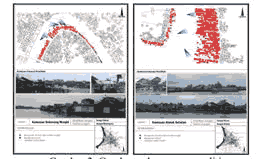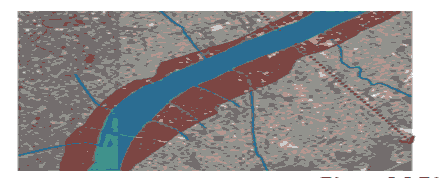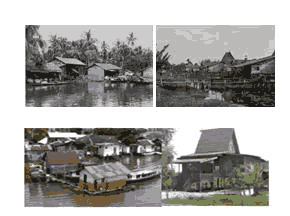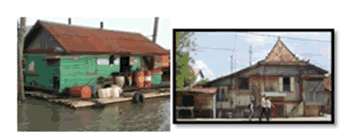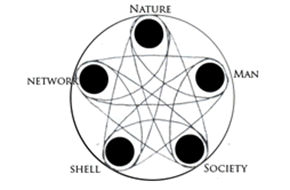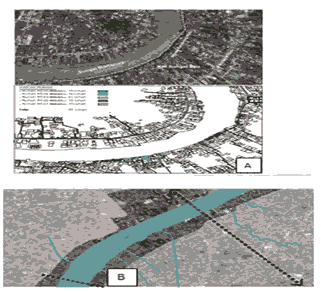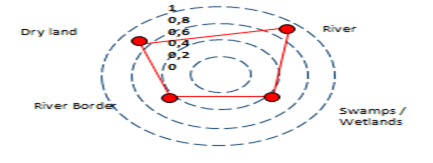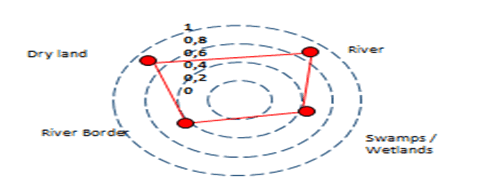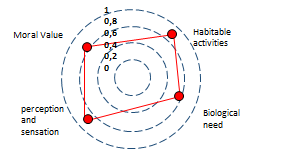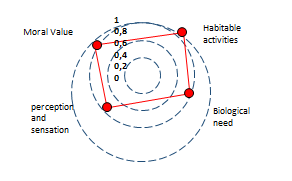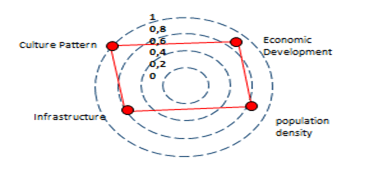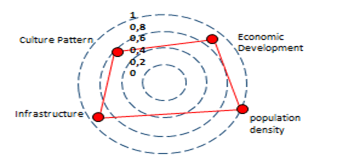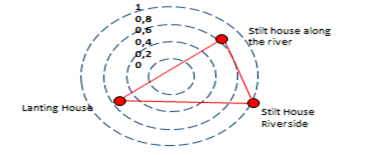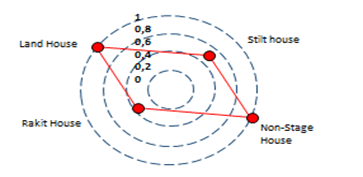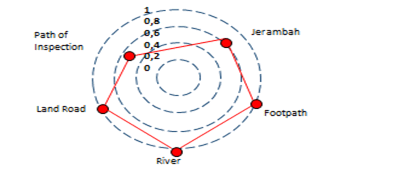Research Article: 2021 Vol: 24 Issue: 1S
Resilience of the Elements of a Riverside Settlement in Banjarmasin and Palembang
Ira Mentayani, University of Lambung Mangkurat
Bambang Wicaksono, University of Palembang
Bani Noor Muchamad, University of Lambung Mangkurat
Abstract
Riverside settlements are formed from the elements of human settlements that are interconnected. The elements of the settlement are in the form of nature, man, society, shell and network. Among the settlements formed from a combination of elements are the riverside settlements in Banjarmasin and Palembang. The riverside settlements in Banjarmasin and Palembang consist of components of riverside houses, stilts-houses, networks, and communities. The purpose of this study was to determine the tendency of residential elements that have the ability to survive in riverside settlements in Banjarmasin and Palembang. The method used in this research is descriptive quantitative with a scoring approach whose assessment is based on the Resilience Radar Index (RRI). This research includes an analysis of each of the elements that make the riverside settlements in Banjarmasin and Palembang last for hundreds of years. The results showed that the elements that tended to have the highest endurance were the elements of nature, protection and networks. The ability to survive these elements is a form of adaptation for riverside settlements in Banjarmasin and Palembang. The ability to sustain the elements is the highest because it has a big influence on the development of urban settlements, even though most of the physical forms of these elements have undergone changes and transformations.
Keywords
Settlement, Stilt-house, Element, Riverside, Resilience
Introduction
Indonesia is an archipelago country that has great potential in the development of waterfront cities. The development of waterfront settlements in Indonesia has 516 cities in its territory with 216 city areas including waterfront cities located on the shores of the sea, lake and river. One of the cities in Indonesia that is located or traversed by a large river is Banjarmasin City and Palembang City. The potential of Banjarmasin City as a river city is actually developing based on a river environment and strengthening its character and potential as a city with riverside architecture and a culture of river life (Mentayani, 2015). Likewise, the settlement on the banks of the Musi River in Palembang. The Musi River was very influential for the community until the 1970s, so that to carry out their daily life they chose to settle on the riverside. The livelihoods of the people on the banks of the Musi River are mostly as fishermen, traders, and day laborers, so the mode of water transportation on the banks of the Musi River is boats.
The facts show that the development and improvement of regional infrastructure as well as the growth of river bank settlement facilities in the two cities have led to a process of change and transformation that is incompatible with the natural cultural conditions of the river, decreasing the existence and quality of life in the riverside area. The character of a river city originating from an urban river is slowly disappearing (Narita et al., 1999; Sarwadi, 2001a, 2002).
Settlements were built without paying attention to the function of the river as a river boundary area, flood plain, and transportation route. This is what makes Banjarmasin City and Palembang City lose their local identities as river cities. Apart from the loss of its identity as a river city, another problem is the destruction of the river environment. Environmental damage is mainly caused by the culture of the people who throw garbage in the river, so that it piles up under houses or settlements. This causes river water to become polluted, hampered river flow, and damage to river ecosystems.
The problems that occur in the city of Banjarmasin, especially those caused by the uncontrolled development of riverside settlements, have been around for a long time. This condition will occur continuously and tends to be more extensive, both in terms of settlement growth and its negative impacts. Likewise the problems in the settlements on the banks of the Musi River in Palembang, cases of changes in settlements occurred in river lands, dwellings and networks. Specifically, there was narrowing of the tributaries, the tributaries became a back area and a garbage dump, the construction of land-patterned dwellings by filling up the swampy area and the construction of concrete trellises that blocked the water flow. River border areas are filled and paths are built. Do hoarding the area under the stage which is a water flow. The changing conditions that become a problem in residential areas in Banjarmasin and Palembang make it important for this research to be carried out. Especially in analyzing the ability to survive the elements of the settlement that are influential and make people choose to stay in these settlements.
Literature Review
Characteristics of Riverside Settlements in Banjarmasin and Palembang
The characteristics of the riverside settlements in Banjarmasin and Palembang can be said to have almost the same cases. The riverside settlements of the city of Banjarmasin in the past as a village in the Banjar area since ancient times were located along the river. These houses are erected always facing the river or above along the river, or if they are built on land facing the road, then the back must be in the river to make it easier to get to water. Each house has a trunk, namely a small room in the river for bathing, washing, a place to defecate and so on. Meanwhile, the villages that are outside the riverside route are a group of houses that are scattered apart on land and far from the riverside.
In a study of riverside settlements in Palembang, Salura (2014) explains that Palembang is one of the river cities that were born from the development of settlements in the riverside area, namely the Musi River and its tributaries. The characteristic of the wide Musi River is very suitable as a means of transportation that supports port and trade activities. The Musi River and its tributaries have been the main means of transportation in the past, connecting the Ulu & Ilir areas of Palembang City.
The Resilience of a city settlement has a program of 100 Resilient Cities or 100 Resilient Cities in the world which aims to help cities in their networks to survive the challenges of social, economic, environmental and physical issues of the city. Community resilience in settlements is a concept of resilience that every region or region needs to have. This is because it can determine the development of a region or region (Indasari, 2020).
Resilience Capability of Riverside Settlements in Banjarmasin and Palembang
Initially, the economic life of agriculture and the social life of settlements depended heavily on river flows or canals so that the location and site of the settlements were closely related to the geography of the riversides (Davis in Oliver, 1997). Likewise, the life of riverside settlements in Banjarmasin and the banks of the Musi River in Palembang. The river was very influential for the people at that time so that to carry out their daily life they chose to settle on the river bank.
Until now, the people who have survived to live on the banks of the river are people who have lived from generation to generation and their lives depend on the river. The results of this civilization will reflect and record traces of the mindset of the people. From a historical perspective, Prayitno (2003) explains that there is a process of evolution of a wandering habitual culture into a sedentary habitual culture. This can be seen from the decrease in traditional houses. During its development, such settlements have become difficult to find due to the process of urbanization pressure which has diminished the traditional values of waterfront housing. The neglect of the river layout has made the river no longer the orientation and location of residential houses due to the development of the city towards the mainland (Figure 1 & Figure 2).
Riverfront houses are a category of settlements in tidal areas. The main reason that the riverside settlement in the form of stilt houses is closely related to the initial function of the river as a transportation route and responding to water spaces is because people think that the existence of a transportation network will create a connected coastal area as a movement path. The existence of residential activities, resulting in the physical conditions of space along the riversides in this area in its development continues to decline in the existence of living, in the form of: 1) Dense human settlements, where there is almost no distance separating the houses (buildings). 2) The growth of the building mass which continues to be concentrated along the river bank causes the area to become denser. 3) The development of community activities on the river has begun to orient to land due to the better road network.
Judging from the type of residence, there are three types of housing on the riverside of the city of Banjarmasin. The first is the dwellings above the river, namely groups of lanting houses, riverside houses with the construction of stilts above the river, and riverside houses with construction on stilts on swamp land. The residential pattern is formed by the river, the bridge connecting the river, the road, the house on the side of the river, the house on stilts across the road (the house on the riverside) with the garden and the alkah tomb) at the back of the house (Menyani, 2015) (Figure 3).
Figure 3: The House on Stilts (Lanting) and The House on Stilts By The River in The City of Banjarmasin in The Past
Source: KIT.NL.LV
Whereas in the settlement on the banks of the Musi River in Palembang, Wicaksono (2020) mentions that there are three types of traditional residential houses that have existed in Palembang society for centuries by responding to the Musi River, namely tidal settlements with colonnaded houses (limas houses, wooden stilt houses ), and a raft house (Figure 4).
Riverside Settlement Elements in Banjarmasin and Palembang
The study of settlement elements in Rapopot (1982) defines settlements, namely core elements or elements that remain relatively unchanged, pheriperal elements or elements that change with the times, new elements. Regarding human settlements, Doxiadis (1968) revealed that the settlement component consists of content and containers. Content is in the form of man and society, while the container is a physical place where humans live includes elements of nature, shell and network. The elements of the edge settlement in Banjarmasin and the Palembang Musi River are part of the settlement unit. The container component or container in a riverside settlement is a combination of three elements: nature (land, water & air), riverside houses, and settlement networks. While the contents are humans and communities who live in it.
In a study related to residential elements in Banjarmasin and the Palembang Musi River, they can be categorized as: 1) Nature in the form of rivers, swamps, wetlands and dry land 2) Shell in the form of lanting houses (Banjarmasin), raft houses (Palembang), stilt-houses (Banjarmasin -Palembang), and the limas house (Pelembang) 3) Network in the form of footpaths (Banjarmasin), Jerambah (Palembang), and footpaths 4) Man and Society are people and people who live in the riverside settlements of the Banjarmasin and Palembang (Figure 5).
Doxiadis (1968) explained that the relationship between ecistic elements can be made into several combinations and each combination will produce a different meaning.
Adaptation to the Riverside Settlement Environment
The form of adaptation or action taken by individuals in an effort to reduce mismatches, Altman, et al., (1980) can be divided into 3 types of adaptation, namely: (1) Adaptation by adjustment, namely the action of reducing conflict by adjusting so that there is harmony between the environment and the environment. individual. (2) Adaptation by reaction, namely the act of rejecting or fighting against the environment by making physical changes to the environment in order to increase harmony between the individual and his physical environment. (3) Adaptation by withdrawal, namely the act of reducing environmental pressure by migrating or moving to another place.
Then in relation to environmental adaptation, the adaptation level theory (Adaptation Level Theory), Bell (2001) reveals that humans adjust their response to stimuli that come from outside, while the stimulus can be changed according to human needs. Everyone has a certain level of adaptation (adaptation level) to certain stimuli or environmental conditions. Furthermore, Adaptation is carried out when there is an imbalance between human interaction with the environment - excessive environmental demands or needs that are incompatible with the environmental situation.
Methodology/Materials
Riverside settlements are shaped by taking into account the natural form (vernacular). The shape of a house with supporting poles in responding to the tides of the river, affects the activities of residents who live on stage and below as a place for river activity, starting from washing, bathing, latrines, storing boats and others.
The data collection method is done through observation (maps, photos, books, journals). The observations made were more directed at the conditions of the dwelling or houses on the banks of the river which had changed and what had changed. Meanwhile, the interviews were conducted more on matters related to resilience and strategies carried out during elevation in riverbank settlements. In this case, it is related to the background, goals, and activities of the people who live on the banks of the Banjarmasin and Palembang's Musi rivers. Second, observations were made by refining the strategy and efforts to adjust the dominant ones to rivers or land. Third, identify data of changes or transformations in riverside settlements in Banjarmasin and Palembang.
Data analysis method is useful in uncovering the findings from quantitative data analysis. This study uses the variables of human settlement elements (Doxiadis, 1968) whose indicators have been identified in riverside settlements in Banjarmasin and Palembang. The first variable is natural elements with indicators of rivers, swamps, wetlands, dry land, and river boundaries. Then the human and community elements with indicators of population, activity, economic growth, education and cultural patterns. Human and community elements are considered to be important elements in identifying the ability to survive riverside settlements, because humans and communities are active factors in settlement development. Furthermore, the protection element which is the result of the culture of the riverside settlement communities in Banjarmasin and Palembang. The elements of protection for riverside settlements are indicators of stilts-houses, lanting houses (Banjarmasin), limas houses (Palembang), and limas houses (Palembang). Finally, Network Elements with indicators for footpaths (Banjarmasin), Jerambah (Palembang), footpaths, and bridges. These settlement elements have an effect on measuring the survival capacity of the people in Banjarmasin and Palembnag. The variables and indicators used in this study are more clearly seen in Table 1.
| Table 1 Settlement Element Variables and Indicators Used |
||||
|---|---|---|---|---|
| Nature | Man | Society | Shell | Network |
| River | Habitable activities | Economy Development | Stilt-house | Titian/Jerambah |
| Swamps/Wetlands | Biological needs | Population | Lanting house/ Rakit house | Footpath |
| Dry land | Perseption and Sensation | Infrastructure | Land house | Bridge |
| River Border | Moral values | Cultural patterns | Road of Inspection | |
The analysis in this study was carried out in stages by an indicator of each residential element to calculate the resilience index. The assessment of settlement elements in this analysis uses the Resilience Radar index, provided that the score index is given an assessment in the range between 0.00 - 1.00. The value of 0.00 is given to the value of resistance which is lowest than and a value of 1.00 is given to the value of the highest resistance (Bolte, 2017). The average result of the scores of all elements is then induced into the level of resistance, namely very high, high, medium, low and very low survival. Indrasari's research (2020) also uses the Resilience Radar index method, but in this study it is more directed at assessing the social, economic, preparedness and physical dimensions. The index score and interpretation of resistance based on Resilience Radar can be seen in Table 2.
| Table 2 Resilience Radar Index |
|
|---|---|
| Endurance Interpretation Index Score | |
| 0,81 – 1,00 | Very high |
| 0,61 – 0,80 | High |
| 0,41 – 0,60 | Medium |
| 0,21 – 0,40 | Low |
| 0,00 – 0,20 | Very Low |
Overview of the Study Area
Research locations are in the cities of Banjarmasin and Palembang by conducting comparative studies at two locations. Banjarmasin and Palembang are cities that have developed from the life of the riverside settlements. This research is focused on the resilience ability of the elements of riverside settlements in Banjarmasin and Palembang which make settlements in these two cities a growing and sustainable settlement (Figure 6).
Figure 6: Map of Research Locations (A) River Bank Settlements in Banjarmasin (2) Settlements on The Banks of The Musi River
Source: Mentayani (2019), Wicaksono (2020)
Results and Findings
Natural Elements of Riverside Settlements in Banjarmasin and Palembang
Basically, the natural elements in riverside settlements are the geographical form of the river. Natural rivers can be classified into water resources. The natural river in Banjarmasin and Palembang is an element that attracts people to occupy and live in.
The results of the analysis on the resistance ability of the natural elements show that the rivers in Banjarmasin and Palembang still have a very big influence even though now their conditions have been replaced by land roads. The riversides in Banjarmasin and Palembang are still the choice for residence, however, the denser occupancy rates tend to push the river into a rush and then over time it becomes land.
Indicators of natural elements in riverside settlements in Banjarmasin and Palembang are rivers which are the main reason or factor for the community in living. In its current condition, rivers still have a role, including being used as a place for bathing, washing and toilet activities, still being used as a transportation route. However, for the level of sustainability, the current condition of the residents' settlements has begun to pull over on the banks of rivers, on swamps and on dry land. River-side houses tend to be abandoned and are getting fewer in number. This natural element radar resilience diagram can be seen in Figures 7 and 8.
Man Elements of Riverside Settlements in Banjarmasin and Palembang
Man as an element of settlement has the ability to survive in riverside settlements with river conditions that are constantly changing. Basically, the rivers in Banjarmasin and the Musi Rivers in Palembang existed long before human existence. Humans get closer to themselves because they see the river as having the potential to live and survive. Man began to form groups, build settlements.
Indicators of human elements in riverside settlements in Banjarmasin and Palembang are inhabited activities where human activities living in riverside settlements tend to create active spaces and are able to adapt. Then there are indicators of biological need, perception and sensation, moral value.
The results of the analysis related to resistance to human elements that tend to have an influence on the ability of resilience in the riverside settlements of Banjarmasin and Palembang are activity factors. The inhabited activities carried out by humans in their settlements and neighborhoods create alternatives or strategies to adapt to rivers to date. This human element radar resilience diagram can be seen in Figures 9 and 10.
Society Elements of Riverside Settlements in Banjarmasin and Palemb
Social society is a human being whose number is more than one person, hang out, for a long time, they unite, form a system of life and then give rise to culture. In the study of riverside settlements in Banjarmasin and Palembang, elements of society experience population density, economic growth of settlements, livelihoods, education and cultural patterns of riverside settlements. This is supported by the existence of supporting facilities in the settlement, such as educational facilities in the form of schools, health facilities in the form of offices and shopping centers. Community linkages as part of the residential element also involve the role of rivers in supporting community economic development. Rivers can be used economically in order to increase people's income, both from owned resources and other economic activities that can be obtained.
The results of the analysis on the resilience ability of community elements can also be said to be high, because the population of people living in riverside settlements tends to increase. This is supported by the availability of land and settlement infrastructure. This community element radar resilience diagram can be seen in Figures 11 and 12.
Shell Elements of Riverside Settlements in Banjarmasin and Palembang
In studies related to riverside settlements, the most important thing is the settlements in the riverside settlements. The pattern of settlement development can be seen is a central pattern with an elongated shape with river lines, a spreading pattern with an elongated shape with road and river lines, and a centered pattern with an elongated shape with a river bank road line.
Specifically, elements of protection in riverside settlements in Banjarmasin and Palembang are riverside houses (lanting houses or raft houses) and houses on stilts. The riverside houses in Banjarmasin and the Palembang Musi River can be referred to as vernacular architecture. During its development, the houses in the Banjarmasin and Palembang settlements had a fairly high ability to survive. This can be seen by the number of dwellings with hundreds of years of age.
As a form of the ability to survive the riverside houses, various forms of community efforts to survive. One of them is by adapting. In the riverside community settlements in Banjarmasin undergo changes or transformations with adaptations in survival. Meanwhile, the riverside settlements in Palembang experienced changes with adaptations and adjustments in survival. Where, the ability to survive on stilt houses and riverside houses is not only influenced by community factors, but is influenced by the changing natural environmental factors of the river. In the process of their ability to survive, the houses on stilts are more adaptive in surviving the riverside settlements in Banjarmasin and Palembang, while the number of lanting houses or raft houses is actually getting smaller. The radar resilience diagram of this protection element can be seen in Figures 13 and 14.
Network Elements of Riverside Settlements in Banjarmasin and Palembang
The road network for riverside settlements at the time of formation was through rivers and tributaries. However, in the current phase or land domination, settlement networks are by land route. In their ability to survive, settlements in Banjarmasin still use walkways to connect their settlements. But there are also various points that have passed the path and are still through the river.
It is different from the survivability of network elements in the settlements on the banks of the Musi River in Palembang. The riverside settlements in Palembang initially used wooden rails as a link between their settlements. Based on time and the development of material technology, wood sprouts were replaced with concrete sprouts. In fact, some of the sprouts have been stockpiled and replaced with paths. On the other side of the riverside settlement in Palembang, the tributaries are covered with concrete and create a river bank inspection road network. The radar resilience diagram of this protection element can be seen in Figures 15 and 16, Table 3.
| Table 3 Score Index Elements of Riverside Settlements in Banjarmasin and Palembang |
||||||||||
|---|---|---|---|---|---|---|---|---|---|---|
| Nature | SI | Man | SI | Society | SI | Shell | SI | Network | SI | |
| Riverside settlement in banjarmasin | River | 0,9 | Habitable activities | 0,6 | Economy Development | 0,8 | Stilt house along the river | 0,8 | Wooden Titian | 1,00 |
| Swamps/Wetlands | 0,4 | Biological needs | 0,6 | Population | 0,9 | Lanting house/ Rakit house | 1,00 | Footpath | 0,9 | |
| Dry land | 0,8 | Perception and Sensation | 0,8 | Infrastructure | 0,6 | Land house | 0,8 | Bridge | 0,8 | |
| River Border | 0,4 | Moral values | 0,6 | Cultural patterns | 0,6 | |||||
| Riverside settlement in palembang | River | 0,8 | Habitable activities | 0,8 | Economy Development | 0,8 | Stilt-house | 0,8 | Jerambah | 0,8 |
| Swamps/Wetlands | 0,4 | Biological needs | 0,6 | Population | 1,00 | Rakit house | 0,4 | Footpath | 1,00 | |
| Dry land | 0,8 | Perception and Sensation | 0,6 | Infrastructure | 0,8 | Land house | 1,00 | River | 0,4 | |
| River Border | 0,4 | Moral values | 0,6 | Cultural patterns | 0,6 | Non-stage house | 1,00 | Road of Inspection | 0,5 | |
| Land Road | 1,00 | |||||||||
Conclusion
Resilience of the Elements of a riverside settlement in Banjarmasin and Palembang is at a relatively high level. This can be seen from the results of the analysis that the community tends to stay in the area of the riverside settlement even though the conditions have undergone changes. This condition shows that basically the people in the riverside settlement areas in Banjarmasin and Palembang actually have a desire to survive, as seen from about 85% of the people choosing to live in riverside settlements. In settlements in Banjarmasin, the resistance of natural elements is still very influential on activities and life, which is supported by shell and network elements. Whereas in the settlements on the banks of the Musi River in Palembang, the level of resistance is more towards the shell and network elements. This is due to the fact that the settlement pattern has led to the mainland as seen from the changes in occupancy and the development of riverside land roads. Meanwhile, the natural elements of the river tend to decline in function and role. The settlement area on the riverside is a flood-prone area, but this desire to survive must be balanced with the ability to adapt to the water environment, both from housing, networks, activities, economic capacity that people think can still be obtained from rivers.
Basically, the ability to survive the elements of the settlement that is most dominant is the element of nature, shell and networks. Where, these three elements can physically be seen and formed in adapting, while humans and society play a role in the effort to survive in the riverside neighborhoods in Banjarmasin and Palembang.
The results of this study can be a contribution of knowledge in an effort to increase the capacity of the community in settlements in Banjarmasin and Palembang in settlement conditions that continue to experience growth and change.
References
- Bell, P.A., Greene, T., Fisher, J.D., & Dan-Baum, A. (2001). Environmental Psychology (5th edition). Belmont, CA: Harcourt College Publisher.
- Bolte, P., Orlowsky, D.B., Marr, S., Moore, S., Rahmadana, M.F., & Sitompul, D. (2017). Resilience radar user manual.
- Creswell, J.W. (2007). Research Design: Qualitative, Quantitative and Mixed Approaches (3rd Edition). Research design: Qualitative, quantitative, and mixed methods approaches.
- Davis, H. (1997). In Paul Oliver (Edition). Encyclopedia of vernacular architecture of the world. Chambrige University Press, 149-150.
- Doxiadis, C.A. (1968). Ekistic, an introduction to the science of human settlements. London: Hutchinson of London.
- Madalia, I. (2020). Community survival capabilities in flood prone settlements in Barabai District, Hulu Sungai Tengah Regency. Regional and Environmental Journal, 8(2), 116-129.
- Mentayani, I. (2016). Identity and existence of riverside settlement in Banjarmasin. Seminar National 2016.
- Mentayani, I. (2015). Adaptive transformation of riverside settlement in Banjarmasin City, Dissertation. Gadjah Mada University.
- Narita. (1998). Study on neighborhood common space typology in urban riverside settlement. Casestudy: Musi River, Palembang, Indonesia, Architectural Institute of Japan, http://ci.nii.ac.jp , Accessed: April 12, 2010.
- Prayitno, B. (2003). Riverside settlement model based on water city occupancy culture. Jurnal Prosiding. Universitas Indonesia : Jakarta.
- Rapoport, A. (1969). House form an culture. The University of Arizona Press.
- Sarwadi, A., Tohiguchi, M., & Hashimoto, S. (2001). A typological analysis of houses and people-gathering places in an urban riverside settlement: A case study in the Musi urban riverside settlement, Palembang City, Sumatra, Indonesia. Journal of Architecture and Planning (Transactions of AIJ), 66(546), 207-214.
- Sari, I. K. (2013). Study on the improvement process by inhabitants in an urban riverside settlement: A case study in the Musi urban riverside settlement, Palembang City, Sumatra, Indonesia. Journal of Architecture and Planning (Transactions of AIJ), (556), 297-304). Changes in Settlement Architecture of Kampung Beting, Pontianak City. Gadjah Mada University.
- Wicaksono, B. (2020). Changes in the elements of the Palembang Musi riverside settlement. Disertasi, Universitas Sriwijaya.
